DeZurik POSITIONER PMV (P36C/P41C) Operating instructions
- Type
- Operating instructions
DeZurik POSITIONER PMV (P36C/P41C)
This device provides precise control for demanding process requirements. By using force balance principle, it converts a signal pressure into proportional air pressure to control pneumatic actuators.
The positioner has a modular design for easy parts replacement, and its housing uses an adjustable O-ring seal.
Some of the key features include:
- P36C model: Accepts a 3-15psi, 3-9psi, or 9-15 psi input signal
- P41C model: Accepts either a 0-20mA or a 4-20mA input signal
- Ingress Protection: IP 65/NEMA 4
- Maximum supply pressure: 1 MPa 145 psi
DeZurik POSITIONER PMV (P36C/P41C)
This device provides precise control for demanding process requirements. By using force balance principle, it converts a signal pressure into proportional air pressure to control pneumatic actuators.
The positioner has a modular design for easy parts replacement, and its housing uses an adjustable O-ring seal.
Some of the key features include:
- P36C model: Accepts a 3-15psi, 3-9psi, or 9-15 psi input signal
- P41C model: Accepts either a 0-20mA or a 4-20mA input signal
- Ingress Protection: IP 65/NEMA 4
- Maximum supply pressure: 1 MPa 145 psi



















-
 1
1
-
 2
2
-
 3
3
-
 4
4
-
 5
5
-
 6
6
-
 7
7
-
 8
8
-
 9
9
-
 10
10
-
 11
11
-
 12
12
-
 13
13
-
 14
14
-
 15
15
-
 16
16
-
 17
17
-
 18
18
-
 19
19
-
 20
20
DeZurik POSITIONER PMV (P36C/P41C) Operating instructions
- Type
- Operating instructions
DeZurik POSITIONER PMV (P36C/P41C)
This device provides precise control for demanding process requirements. By using force balance principle, it converts a signal pressure into proportional air pressure to control pneumatic actuators.
The positioner has a modular design for easy parts replacement, and its housing uses an adjustable O-ring seal.
Some of the key features include:
- P36C model: Accepts a 3-15psi, 3-9psi, or 9-15 psi input signal
- P41C model: Accepts either a 0-20mA or a 4-20mA input signal
- Ingress Protection: IP 65/NEMA 4
- Maximum supply pressure: 1 MPa 145 psi
Ask a question and I''ll find the answer in the document
Finding information in a document is now easier with AI
Related papers
-
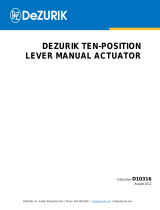 DeZurik ACT LEVER TEN POSITION Operating instructions
DeZurik ACT LEVER TEN POSITION Operating instructions
-
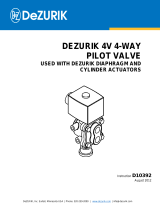 DeZurik PILOT VALVE SOLENOID (4V) 8342 4-WAY FUW DIAPH/CYL Operating instructions
DeZurik PILOT VALVE SOLENOID (4V) 8342 4-WAY FUW DIAPH/CYL Operating instructions
-
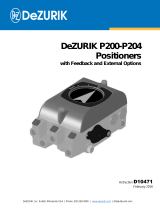 DeZurik POS VAC 200 (P200-P204) Operating instructions
DeZurik POS VAC 200 (P200-P204) Operating instructions
-
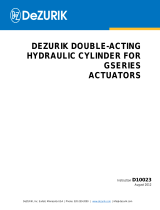 DeZurik CYL HYDRAULIC G-SERIES Operating instructions
DeZurik CYL HYDRAULIC G-SERIES Operating instructions
-
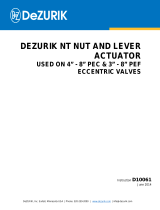 DeZurik ACT 2" NUT/LEVER (NT/LV/LVF) ECCENTRIC Operating instructions
DeZurik ACT 2" NUT/LEVER (NT/LV/LVF) ECCENTRIC Operating instructions
-
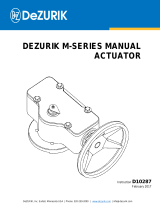 DeZurik ACT M-SERIES MANUAL AWWA Operating instructions
DeZurik ACT M-SERIES MANUAL AWWA Operating instructions
-
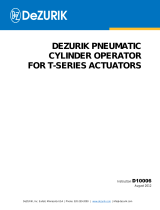 DeZurik CYL T-SERIES AWWA Operating instructions
DeZurik CYL T-SERIES AWWA Operating instructions
-
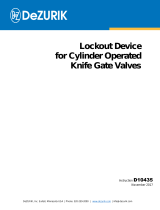 DeZurik LOCKOUT (LK) KGC VALVES Operating instructions
DeZurik LOCKOUT (LK) KGC VALVES Operating instructions
-
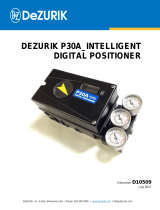 DeZurik POSITIONER PMV (P30A_) Operating instructions
DeZurik POSITIONER PMV (P30A_) Operating instructions
-
 DeZurik NECK EXTENSION (ENK) FUW LA/M/T SERIES ACTUATORS Operating instructions
DeZurik NECK EXTENSION (ENK) FUW LA/M/T SERIES ACTUATORS Operating instructions































